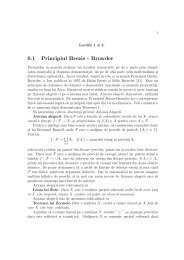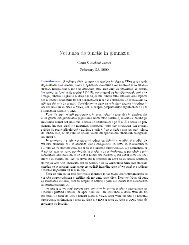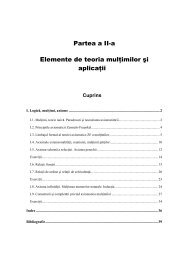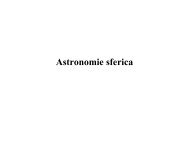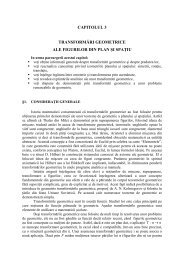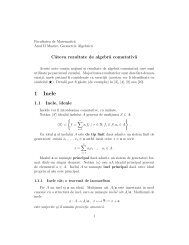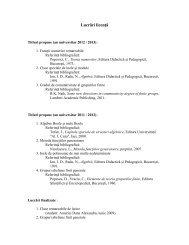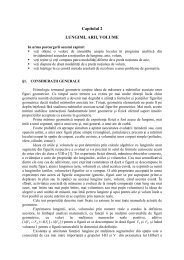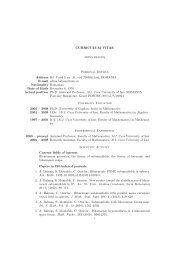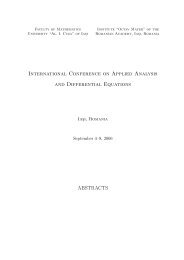ecuatiile perpendicularei comune a doua drepte, proiectii, simetrii
ecuatiile perpendicularei comune a doua drepte, proiectii, simetrii
ecuatiile perpendicularei comune a doua drepte, proiectii, simetrii
Create successful ePaper yourself
Turn your PDF publications into a flip-book with our unique Google optimized e-Paper software.
7) Care din urmatoarele plane sunt perpendiculare?<br />
(P) 2x+3y-z+5=0, (Q) 2x+y+7z-1=0, (R) 4x-2y+2z-3=0.<br />
Rezolvare: <strong>doua</strong> plane sunt perpendiculare daca si numai daca vectorii normali<br />
lor sunt ortogonali. Se verifica P⊥Q si P⊥R.<br />
8) Scrieti <strong>ecuatiile</strong> <strong>perpendicularei</strong> <strong>comune</strong> a <strong>drepte</strong>lor a) (d1) x−7<br />
1<br />
si (d2) x−3 y−1<br />
−7 = 2<br />
(d2) : x = 4 + s, y = −2 − 4s, z = 9 + 2s; c)<br />
si<br />
= y−3<br />
2<br />
= z−9<br />
−1<br />
= z−1<br />
3 ; b) (d1) : x = 1 + 2t, y = 3 + t, z = −2 + t si<br />
x + 4z + 1 = 0,<br />
x − 4y + 9 = 0<br />
y = 0,<br />
x + 2z + 4 = 0.<br />
Rezolvare: Verificam initial ca cele <strong>doua</strong> <strong>drepte</strong> sunt necoplanare.<br />
Metoda 1: Determinam picioarele <strong>perpendicularei</strong> <strong>comune</strong> folosind <strong>ecuatiile</strong><br />
parametrice ale celor <strong>doua</strong> <strong>drepte</strong> si impunand ca vectorul director al <strong>drepte</strong>i cautate<br />
sa fie perpendicular pe ambii vectori directori ai celor <strong>doua</strong> <strong>drepte</strong> date.<br />
Metoda 2: Perpendiculara comuna se obtine ca intersectia dintre <strong>doua</strong> plane π1<br />
si π2, π1 fiind planul proiector al <strong>drepte</strong>i (d1) pe planul ce contine (d2) si este paralel<br />
cu (d1), iar π2 este planul proiector al <strong>drepte</strong>i (d2) pe planul ce contine (d1) si este<br />
paralel cu (d2). Se obtin <strong>ecuatiile</strong>:<br />
a) x−1<br />
2<br />
= y<br />
1<br />
= z+3<br />
4<br />
; b) x+1<br />
2<br />
= y−6<br />
−1<br />
z−5 = −3 ; c)<br />
y + z − 2 = 0,<br />
2x + 5y + 4z + 8 = 0.<br />
9) Sa se gaseasca proiectia punctului A pe planul π pentru cazurile: a) A(4,-3,1)<br />
si π : x + 2y − z − 3 = 0; b) A(2,1,1) si π : x + y + 3z + 5 = 0; c) A(-1,3,3) si<br />
π : x + y + z + 1 = 0.<br />
z−1<br />
−1<br />
Rezolvare: a) Ecuatiile <strong>perpendicularei</strong> din A pe planul dat sunt x−4 y+3<br />
1 = 2 =<br />
iar intersectia dintre aceasta si plan este A’(5,-1,0); b) A’(1,0,-2); c) A’(-3,1,1).<br />
10) Stiind ca M(3,4,2) este piciorul <strong>perpendicularei</strong> coborate din origine pe un<br />
plan π, sa se scrie ecuatia acestui plan.<br />
Rezolvare: dreapta OM este perpendiculara pe plan, deci un vector normal<br />
planului este −−→<br />
OM(3, 4, 2). Planul π este unic determinat de punctul M si de vectorul<br />
normal calculat anterior si se obtine 3x + 4y + 2z − 29 = 0.<br />
11) Sa se determine proiectia <strong>drepte</strong>i d pe planul π, in situatiile urmatoare:<br />
a) d : x y−4 z+1<br />
x−4 y+2<br />
4 = 3 = −2 , π : x − y + 3z + 8 = 0; b) d : 2 = 3<br />
π : x + 6y − z − 2 = 0; c)<br />
x − y − 3z = 0,<br />
2x − y + 2z − 3 = 0,<br />
= z+1<br />
4 ,<br />
si π : x + 6y − z − 2 = 0.<br />
Rezolvare: a) Se verifica faptul ca dreapta d nu este perpendiculara pe planul<br />
π (in caz contrar proiectia ar consta dintr-un singur punct, proiectia oricarui punct<br />
2



